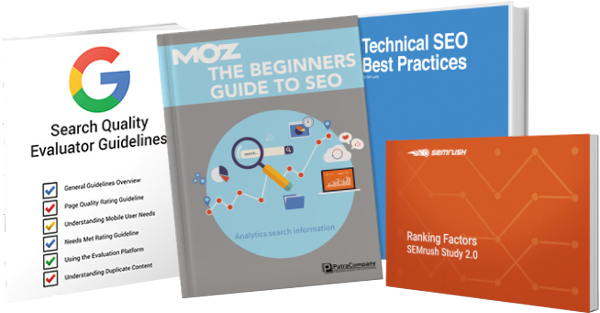What is content optimization, and why is it essential for your SEO content strategy? Learn how to optimize content to boost your SEO efforts in this complete guide.
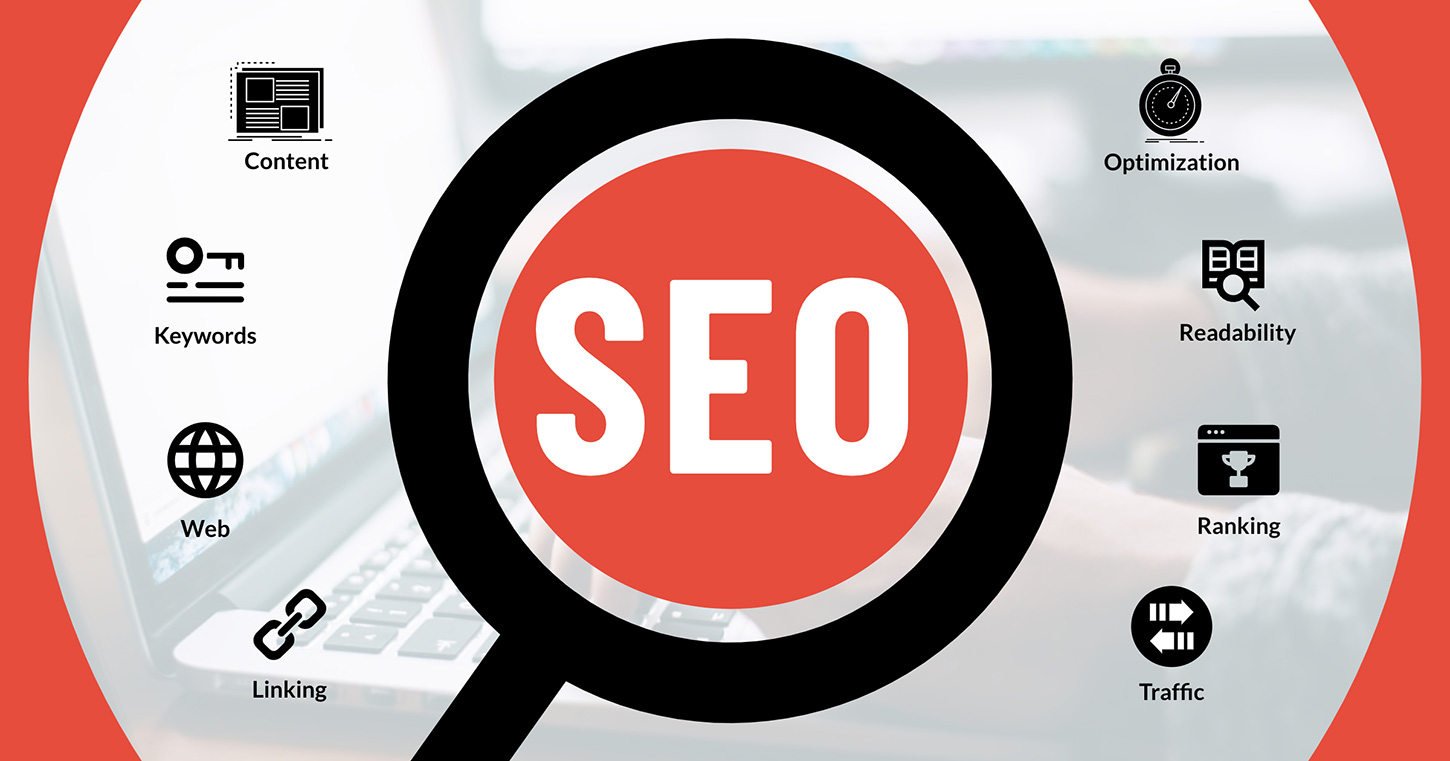
Content optimization is making your website's content more appealing to search engines and users.
Optimizing content includes several Search Engine Optimization (SEO) practices. For example, page optimization requires:
Content optimization for SEO also has several benefits. For example, optimized content will:
As you can see, an effective SEO content strategy takes more than content writing.
Want 36 actionable steps to optimize your content before publishing?
Content optimization is an integral part of a successful content marketing strategy.
When it comes to your startup content SEO strategies will improve your search engine ranking, bring in more revenue, and help you become an authority in your field.
According to a study by SmallBizGenius, over 90% of businesses use content marketing strategies. And 72% of marketers reported improved engagement with content marketing.
Optimizing content also helps your content rank higher on Google's search results. Google's ranking algorithms determine which pages are the most valuable and relevant.
According to WordSream, the first page of Google's search results attracts 71% to 92% of web traffic.
These statistics show how crucial it is to reach page one of Google's search results. And effective website optimization and content marketing will get you there.
Optimize your content and drive more traffic to your website with these ten SEO content strategy tips:
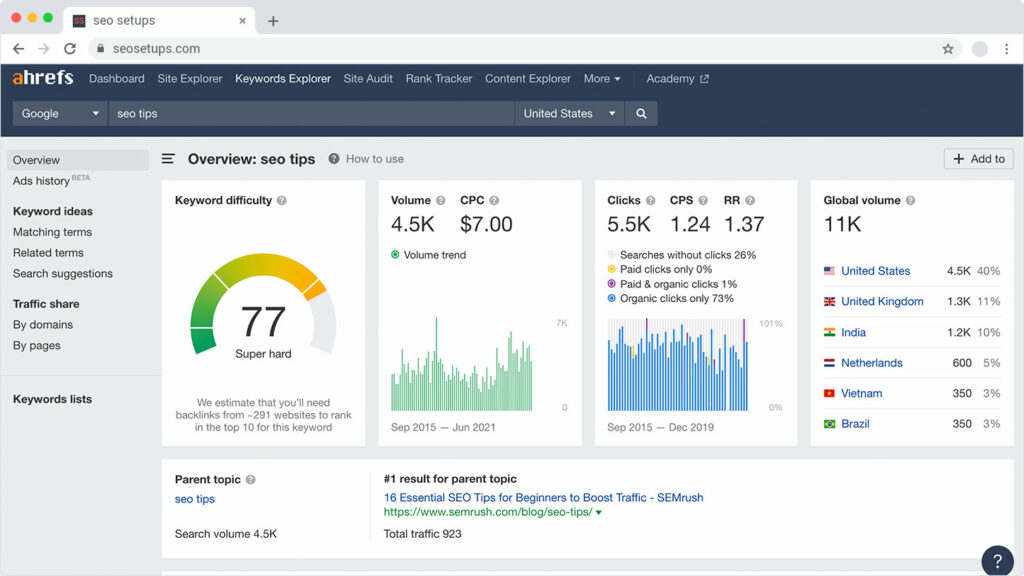
Keywords optimization makes your content discoverable in search results and helps your content outrank the competition. Target specific keywords and phrases your audience is searching for in Google.
Next, optimize content for SEO by adding your target keyword in the meta title, meta description, URL, subheadings, and body copy.
However, avoid keyword stuffing and don't force the keywords in the content. Place your keywords in areas that make sense.
How to choose the right keyword? Below are a few factors to consider:
Get started with keyword research using these paid and free keyword research tools:
Free Keyword Research Tools
Paid Keyword Research Tools

Search intent describes the reason someone conducts a specific search. It's a critical ranking factor.
Search engines provide users with the most relevant result for their search query. If your content doesn't match a user's search intent, it will not rank. That's why it's essential to write content that matches the user's search intent.
For example, say your target keyword is "how to do keyword research." The user is looking for a step-by-step guide on how to do keyword research. Therefore, you would write a tutorial or guide and not review the best keyword research tools.
How to determine search intent? One way to determine search intent is to research the SERPs. Type in your target keyword and review the search results. See what search intent types Google deems the most relevant.
The four primary search intent types:

Title tags are the clickable headlines that appear in search results. It's what users see first to determine which result to click.
That's why it's critical to write a compelling title that attracts clicks and meets user intent. A lousy headline could hurt your SEO efforts.
Best practices for optimizing title tags:
1. Test your titles. (Use this free tool to analyze your titles)
2. Write unique titles for each page. Avoid creating duplicate titles.
3. Keep titles between 40–60 characters long (Max width 850px). This is the optimal length to avoid truncation in search results. (Check your title length here)
4. Include your target keywords. Keywords make your content discoverable in search results, improve rankings, and attract clicks.
5. Include power words. Power words grab attention, evoke emotion, and attract clicks. Use words like Free, New, Best, How, Why, What, Quick. (See a list of power words here)
6. Add semantically related words (LSI Keywords). Terms related to your target keyword add relevance and increase ranking potential. For example, if your target keyword is "car," then "automobile" is an LSI keyword. (Use this free tool to find LSI Keywords)
7. Add numbers. Studies show an increase in clicks when adding numbers to a title. For example, "7 Easy SEO Tips to Improve Your Website."
8. Add a Call to Action (CTA). Use action words like download, learn, watch, listen, view, and buy. For example, "Download our Free SEO Tips Guide."
9. Include an offer. People like incentives and free stuff. For example, "The Ultimate SEO Guide [Free PDF Download]."
10. Add current dates. People and search engines like fresh content. For example, "Best SEO Tips in 2023."
11. Use parentheses or brackets to draw attention. For example, "How to Convert Website Visitors (Complete Guide)."
12. Target attention-grabbing headlines. These headlines are discoverable in searches, attract clicks, gain social shares, and earn Featured Snippets:

The meta description is a summary of a page displayed below the meta title in search results. It's like an ad pitch to convince users to click the link.
Meta descriptions do not directly affect search rankings. However, they do influence click-through rate (CTR), which is a ranking factor.
It's critical to write a compelling meta description. Inform users what the page is about and convince them to click the link.
Best practices for optimizing meta descriptions:
1. Write unique meta descriptions for each page. Avoid duplicate meta descriptions.
2. Keep meta descriptions between 50–160 characters long (Max width 920px). This is the optimal length to avoid truncation in search results. (Check your meta description length here)
3. Include your target keyword. Keywords make your content discoverable in search results, improve rankings, and attract clicks.
4. Match search intent. Accurately summarize the content and make sure it aligns with search intent.
5. Attract clicks by writing compelling copy. Compel users to click the link. Describe what they'll learn, the problems the content solves, or the benefits they'll receive.
6. Include a Call to Action (CTA). CTAs encourage users to act. For example, add a line like "Get the answers you need, now!"
7. Avoid misleading copy to attract attention. Writing incorrect statements about the page can negatively affect your SEO efforts. Users will click off the page, which will affect your bounce rate.
8. Don't include quotation marks. They interfere with the meta description HTML. Google cuts off the description at the quotation mark. To prevent this, remove non-alphanumeric characters from meta descriptions.
Note: These tips will help drive traffic and improve the click-through rate. However, Google can rewrite meta descriptions and display a random sentence from your content. Avoid this by matching the user's query and summarizing the content accurately
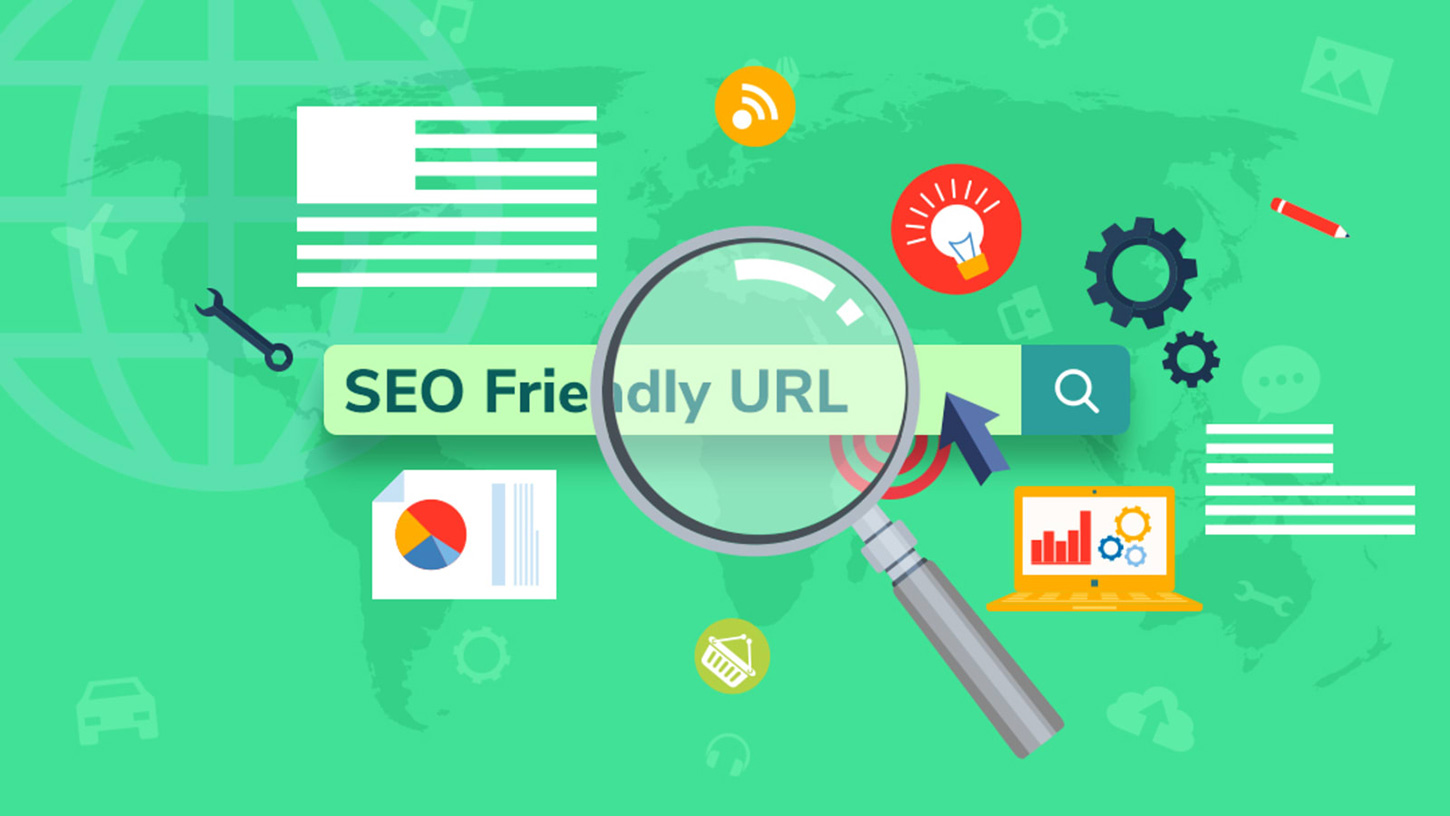
Good URL structure helps users and search engines understand the page. URLs should be both user-friendly and relevant to your content.
Best practices for creating SEO and user-friendly URLs:
1. Write a unique URL for each page. Avoid duplicate URLs.
2. Use lower case letters. Mixing uppercase and lowercase letters can cause case-sensitive and duplicate content issues. It also makes URLs messy which can affect user experience.
3. Separate the words with hyphens to improve readability. Avoid underscores, plus symbols, and blank spaces to avoid potential URL problems.
4. Keep URLs simple, concise, and short (2-4 words). Shorter URLs improve user experience. They're also easier to remember, read, share, and use for advertising.
5. Include your target keyword. Keywords make your content discoverable in search results, improve rankings, and attract clicks.
6. Be descriptive. Describe the page accurately in a shortened format.
7. Avoid adding numbers, dates, and months. Keep your URLs evergreen and make them future-proof for later edits or updates.
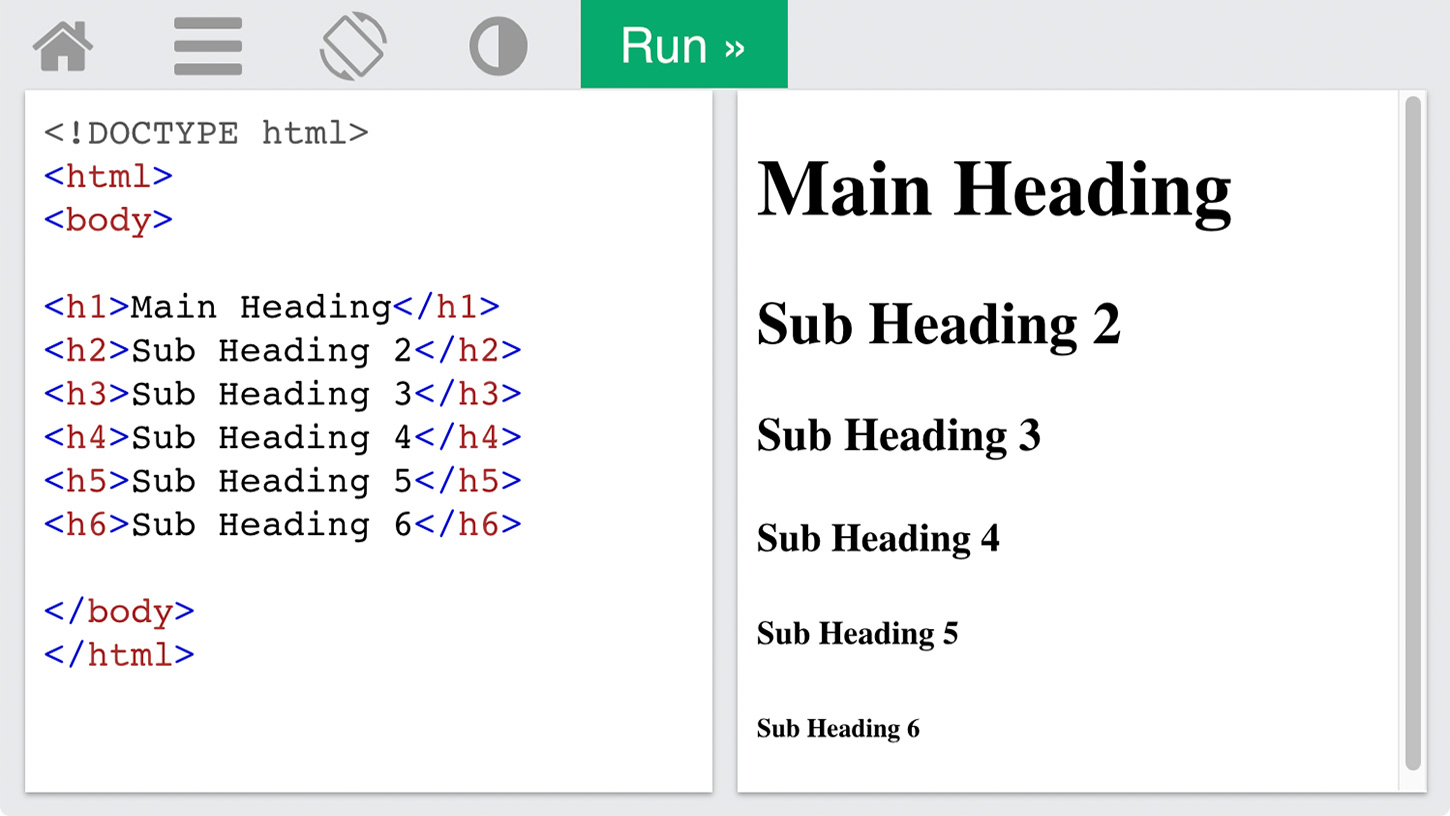
Optimizing your content structure with topic headings is essential for SEO. Header tags organize your content, improve readability, enhance user experience, and boost your SEO!
Header tags are HTML elements used to define the headings of a page. They have several benefits. For example, headings:
The six header tags are H1, H2, H3, H4, H5, and H6. H1 is the highest, most important level, and H6 is the lowest, less important level. Each header also serves a different purpose. For example:
Best practices for using header tags:
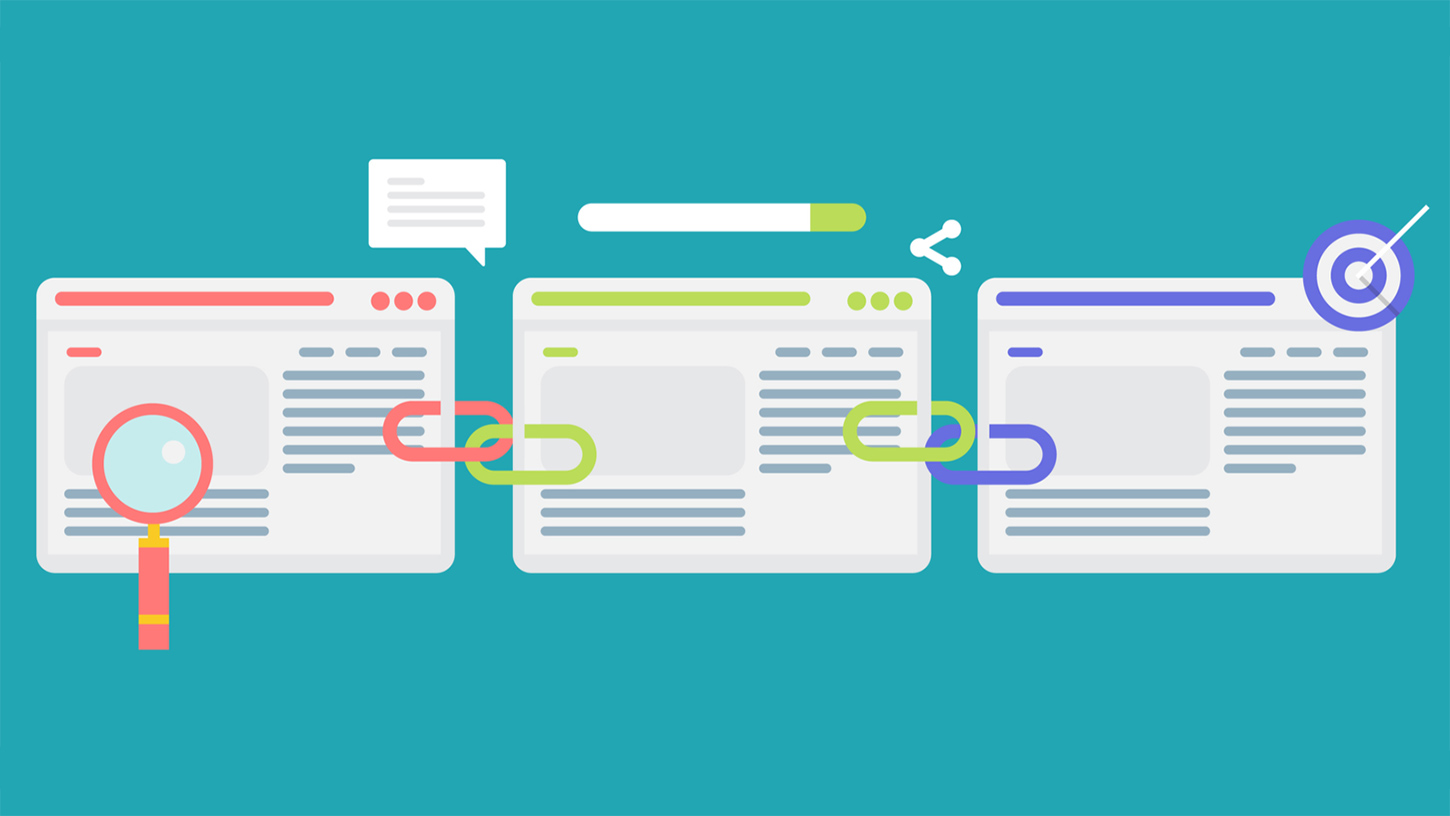
Linking is a critical ranking factor that will help boost your SEO efforts. The two types of links are internal and external.
Internal links direct users from one page to another on your site. They have several SEO benefits. For example, internal links:
External links direct users to a different website. Linking to high-authority websites also has SEO benefits. For example, quality external links:
Best practices for optimizing links:
1. Use appropriate anchor text. Anchor text is the clickable text in a hyperlink. It's a ranking factor that helps search engines and users understand the context of the link.
2. Optimize anchor text by linking descriptive text with relevant keywords instead of using naked links. This approach helps search engines and users know what to expect if they follow the link. Also, avoid vague text like "click here" or "this page."
3. Make sure the link is relevant. Avoid linking to pages not relevant to the content or the anchor text you're linking. This approach will hurt user experience and send bad signals to search engines.
4. Use links to add value and information. Avoid linking for the sake of linking. Make sure the links make sense and match the context of the content.
5. Use "DoFollow" links. DoFollow is an HTML attribute that tells search bots how to follow links. It's critical to pass link juice to internal pages. It helps them rank in search results. Conversely, NoFollow links block search bots from following the link.
6. Link deep into your site. Avoid linking to primary pages like the homepage and the contact page. Most sites have several links to top-level pages. Instead, strengthen internal pages to boost the overall SEO of your site.
7. Use a reasonable number of internal links. You don't need tons of links in your content. Add 2-5 links per post depending on the length of the post. For example, five internal links are sufficient for a 1,200 word post. Also, spread the links evenly throughout the content and avoid clustering them together.
8. Link to product pages and relevant blog posts. Visit older posts on your site and link back to newer posts. This approach helps users find new content. Driving traffic to other posts will also help them rank higher in search results.
9. Link to authoritative sites. Search engines will reward your page if you link to reputable resources throughout your post.
10. Open external links in a new window. You don't want users leaving your site! Setting external links to open in a new window will help reduce bounce rate.
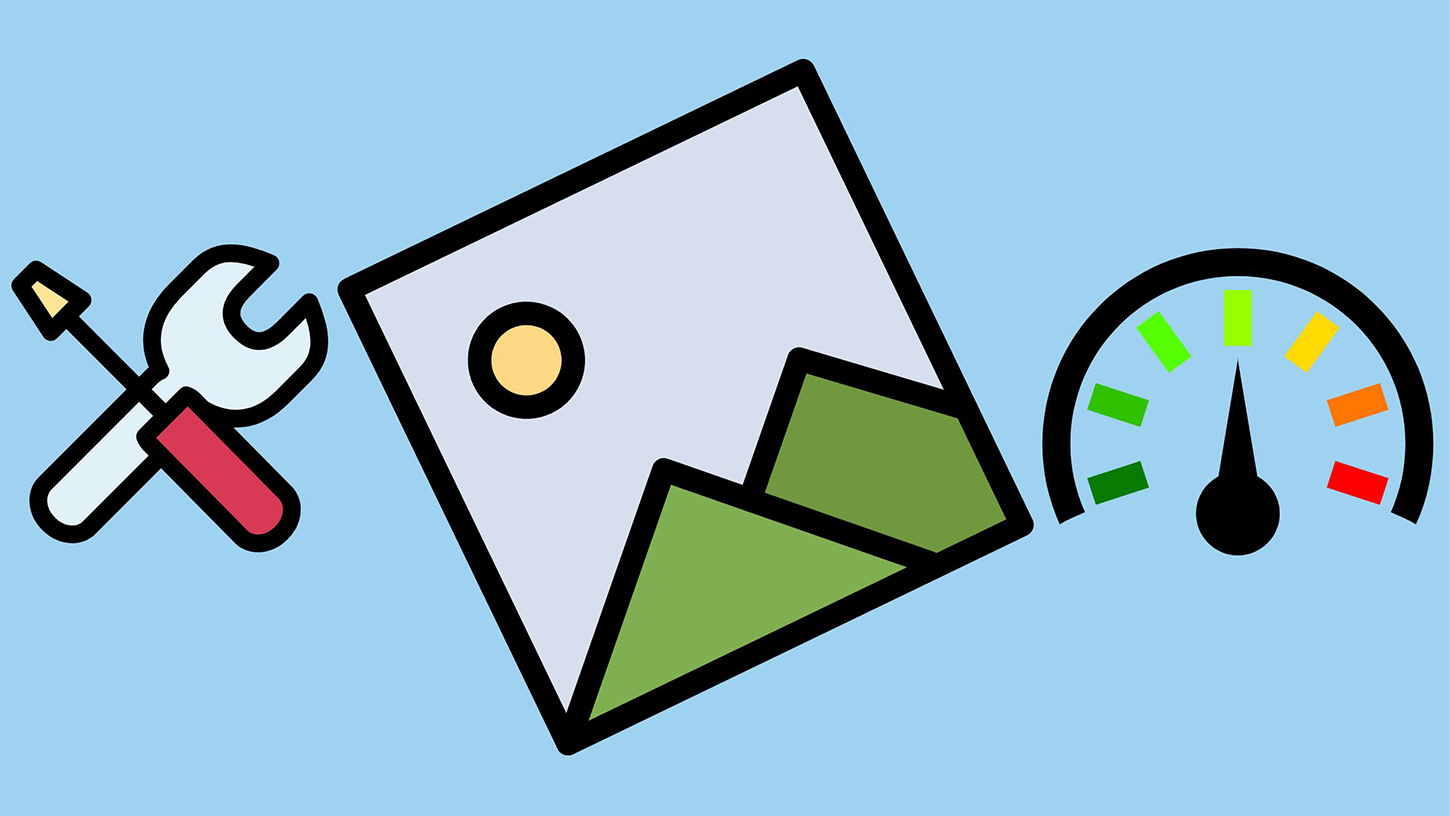
Image SEO is essential and often overlooked in a content optimization strategy. Optimizing your images will boost your site's performance, increase traffic, and improve user experience.
For example, optimized images:
Best practices for optimizing images:
1. Name your image files appropriately. Optimized image titles are more discoverable in image searches and help bring traffic. Write short but descriptive file names and include relevant keywords. Also, avoid long file names and vague titles like IMG007.jpg.
2. Write descriptive Alt text and include relevant keywords. Alt text helps search engines and screen readers understand the image. It also improves topical relevance and boosts rankings in Google Images.
3. Choose the best image file type. Below are the most common file formats for the web:
4. Compress your images before uploading them to your site. Compressing images with a large file size improves page loading speed. Use tools like Photoshop or TinyPNG to compress images. Aim for file sizes 150kb or smaller. Alternatively, you can use a CDN service to deliver optimized images.
5. Scale your images to the actual display size. For example, if the display area of your blog pages is 720px wide, resize images to 720px before uploading. This approach reduces the file size and improves page loading speeds.
6. Use original images instead of stock images. Too many sites use the same generic stock photos. Original, high-quality images have more SEO benefits. For example, authentic images improve user experience and ranking for image searches.
7. Use relevant images. Make sure your images relate to the topic. Avoid adding random or irrelevant images for the sake of adding visual content.
8. Optimize image placement. Place images near relevant text or where they add value to the page. Also, consider placing the most important image near the top of the page.
9. Use image captions wherever possible. Captions with relevant keywords help images rank, improve click-through rate, increase topic relevance, and improve user experience.
10. Use images, infographics, and videos in blog posts. Visual content has several SEO benefits. Visuals help readers and search engines understand your content. They also increase user experience, engagement, social sharing, topic relevance, and more.
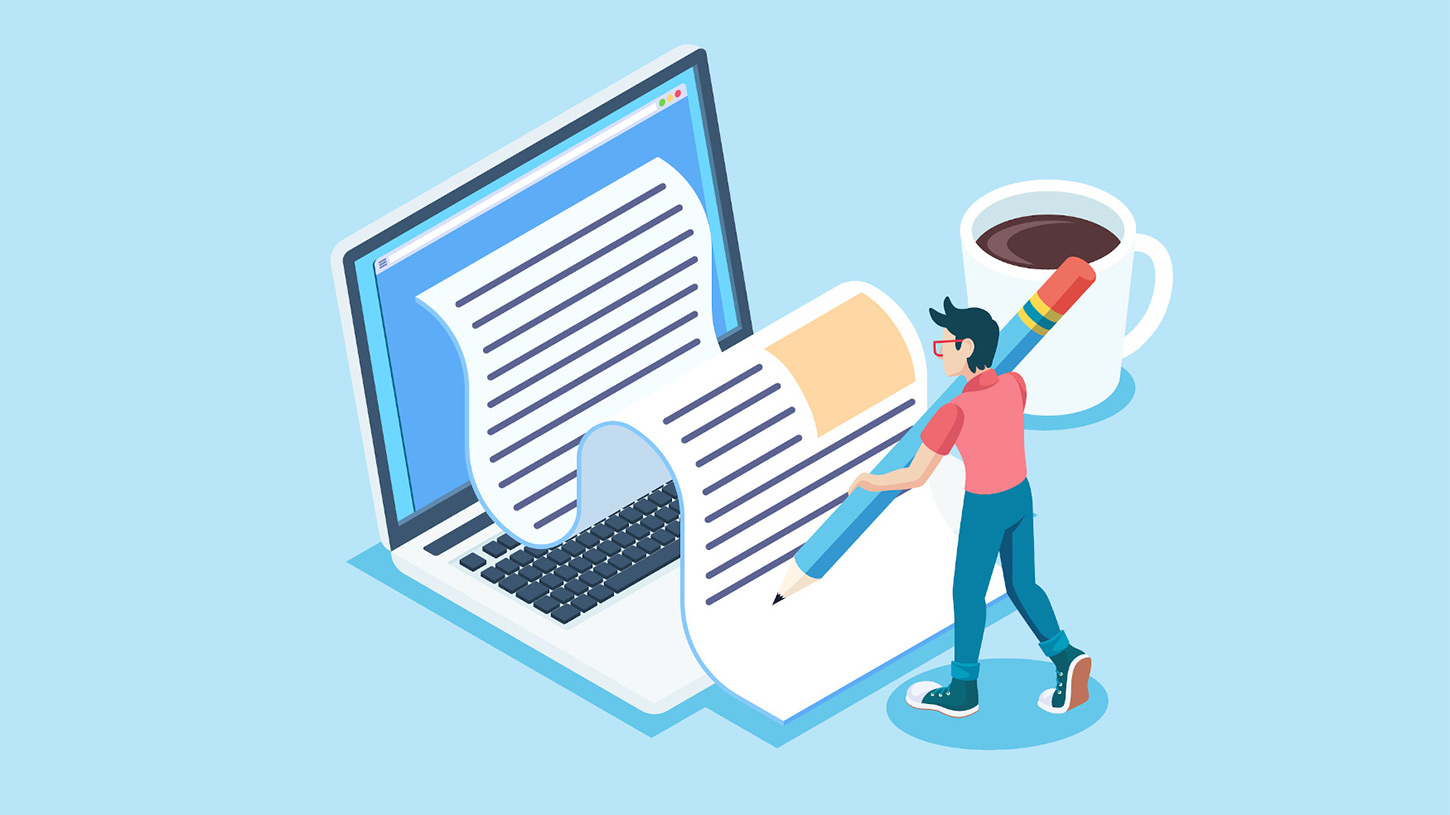
What is long-form content? Long-form content is typically over 1,000 words. The minimum length should range between 1,000 and 2,000 words.
Long-form content also covers a topic in-depth, engages users, and provides value. It should also educate and inform those looking for answers to questions or want to learn more about a topic.
Conversely, short-form content or thin content has fewer than 500 words. Thin content often lacks topical depth, expertise, and engagement.
Writing in-depth content has several SEO benefits. For example, quality content:
Also, studies show content over 2,000 words dominate the top 10 results on Google. However, Google doesn't decide page ranking by its word count.
You must consider several other factors to improve rankings. For example, quality content must include:
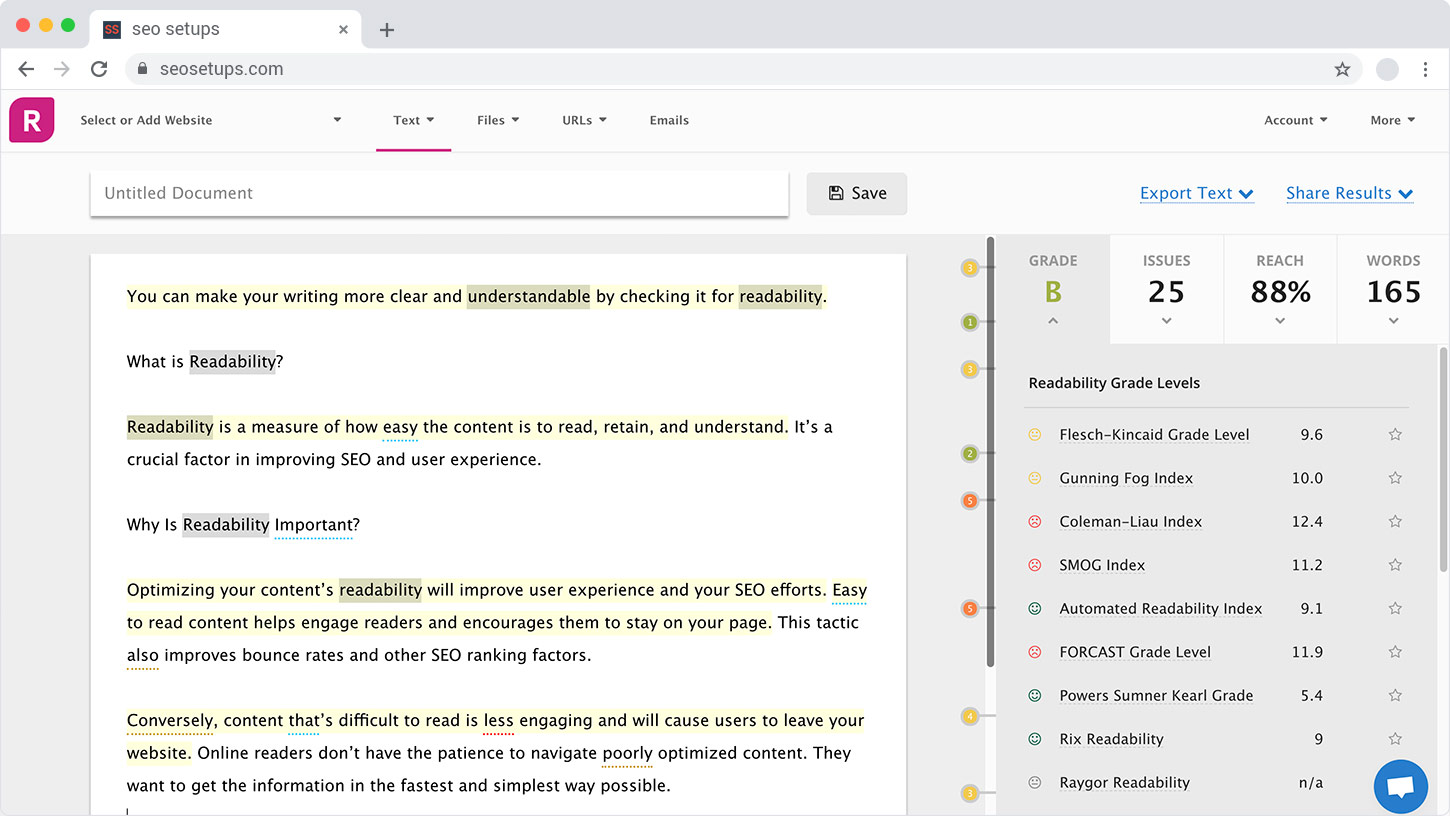
Readability is another factor often overlooked in a content optimization strategy. You can make your writing more clear and understandable by checking it for readability.
Readability is a measure of how easy the content is to read, retain, and understand. It's a crucial factor in improving SEO and user experience.
Optimizing your content's readability will improve user experience and your SEO efforts. Easy to read content helps engage readers and encourages them to stay on your page. This tactic also improves bounce rates and other SEO ranking factors.
Conversely, content that's difficult to read is less engaging and will cause users to leave your website. Online readers don't have the patience to navigate poorly optimized content. They want to get the information in the fastest and simplest way possible.
Also, improving user engagement sends positive signals to search engines. These signals indicate your website is a high-quality site with helpful information that provides value.
If you want your content to rank higher on search results, take readability seriously.
Readability helps improve these metrics, which affect SEO:
Readability tools calculate the readability score based on several factors and formulas. Typical factors used for measuring readability include:
Several online content optimization tools can determine the readability of your content. For example, the Hemingway App is a popular free tool to check readability.
According to this Nielsen Norman Group study, people read 20-28% of online content. It means they are only scanning the content and finding keywords.
The study also says site visitors will take 10-20 seconds to decide whether to keep reading or leave the site.
It's crucial to hook readers quickly and keep them engaged. That's why your content must be easy to read, engaging, clear, concise, factual, high-quality, and scannable.
Professional copywriters, marketers, bloggers, and SEO exports use these readability best practices in their content optimization strategy:
1. Remember, less is more: Keep your content concise, engaging, and informative.
2. Check spelling and grammar: Fix spelling and grammar mistakes. Content full of typos affects user experience, which impacts SEO.
3. Write in Active Voice: Active voice has a strong, direct, and clear tone. It's also more engaging and easier to understand.
4. Avoid Passive Voice: Passive voice makes text appear distant and less clear. Sentences also become wordy and harder to understand.
5. Write short sentences: Keep sentences under 20 words. Short, concise sentences improve user experience. For example, shorter sentences:
6. Keep paragraphs short: Long paragraphs are hard to read. Keep paragraphs between 3-5 sentences long. This approach also improves user experience. For example, short paragraphs:
7. Limit difficult words: Use short, simple words with fewer syllables. They're easy to read, understand, and retain. Avoid long, complex words, uncommon words, or technical terms when possible.
8. Use header tags to structure your content: Separate content with descriptive headings and subheadings. Try to add a subheading every 300 words. A wall of text without headings is difficult to read and consume.
9. Use bullet points and numbered lists: Highlight important information with structured lists. This approach shortens your sentences and makes it easier for the reader to find key points. It also optimizes the content for Google Featured Snippets.
10. Aim for an optimal reading grade level: Aim for an eighth-grade reading level. That will ensure your text is readable by roughly 85% of the public. Studies also show this reading level is easy to read and understand.
11. Avoid wordiness: Use plain language. Cut unnecessary jargon, fluff, and fancy vocabulary. Long, wordy sentences are hard to read and retain.
12. Use transition words: Transition words improve the flow of your content. Words like "also" and "for example" help the reader progress from one idea to another.
13. Write in a conversational tone: A conversational tone is more genuine and human. Plus, you'll naturally use simple words and sentences, which are easy to read.
14. Offer actionable advice: Provide advice or steps the reader can apply immediately. Actionable content is a great way to encourage user engagement!
15. Think about the tone: The right tone can add emotion in your copy, making it relatable, engaging, and a more personalized experience.
16. Make your point quick: For example:
17. Avoid consecutive sentences: Try not to start successive sentences with the same word. The reader might think it's repetitive or annoying.
18. Font size and style: Use easy-to-read font sizes and font styles. The optimal font size for body text is 16px. Also, avoid fancy font styles that are distracting and difficult to read. Use basic fonts like Arial, Open Sans, Roboto, or Verdana.
19. Add visual content: Studies show images, videos, and infographics increase user engagement and help keep readers on the page longer. They also break up big blocks of text and make the content more visually appealing.
20. Keep it simple: Ensure your content structure and formatting is simple, engaging, scannable, and visually pleasing.
21. Do thorough research on the topic: Provide factual data and be specific with information. Avoid vague adjectives, lengthy opinions, and off-topic information. This approach also improves the credibility of your content.

These eight additional SEO optimization tips will help you optimize your content and bring more traffic:
1. Create engaging content to drive traffic to your site. For example, popular content types include:
2. Optimize content for question-related searches. For pages targeting question-related terms, start the page with a question related to your topic. Then answer it in one or two sentences. Then below the answer, go more in-depth. This tactic increases the chance to earn a Featured Snippet.
3. Write a compelling introduction paragraph. You only have a second to hook a visitor once they land on your page. Keep your intro concise and provide enough info to keep readers interested.
4. Write a conclusion to summarize the key takeaways from the post. Don't leave the reader hanging. A concluding paragraph provides closure, summarizes key points, and conveys your message one last time.
5. Keep your content fresh by updating existing posts. Search engines and users want fresh content. Updated content improves traffic, click-through rate, content quality, authority, user experience, and more. Plus, updating old content takes less work and delivers faster results. For example, here are ways to optimize older content:
6. Organize blog posts using the topic cluster model. A content hub or pillar page organizes content around a specific topic. For example:
7. Add a Call-to-Action (CTA) on blog posts. A compelling CTA will send users to a product page, service page or instruct them to take some action. This move improves bounce rate, click-through rate, conversions, and more.
8. Encourage social sharing. Social media can help get your content in front of a larger audience. This approach will drive more traffic, improve rankings, earn backlinks, boost engagement, and more.
With so much content online, you have to create high-quality content to gain an edge over your competitors.
Use these content SEO strategies to create high-value content that attracts and converts visitors.
Also, don't forget about older content on your website. Revisit these pages and apply these SEO content optimization tips to boost traffic and conversions.
Common questions on how to optimize content for SEO to improve traffic, rankings, and user experience.
Follow the content SEO best practices in this complete guide. Then download our Content Optimization Checklist to access 36 actionable steps to optimize your content before publishing.
Below are the nine top keys to content optimization for SEO:
Content optimization is the process of improving the quality and relevance of content on a website. The goal is to provide quality content better to meet the needs and interests of your target audience.
SEO, on the other hand, involves optimizing various on-page and off-page factors. The goal is to increase a website's visibility and ranking in search engine results pages (SERPs).
While content optimization focuses on improving the user experience and providing value to visitors, SEO primarily drives traffic and improves a website's visibility in SERPs.
